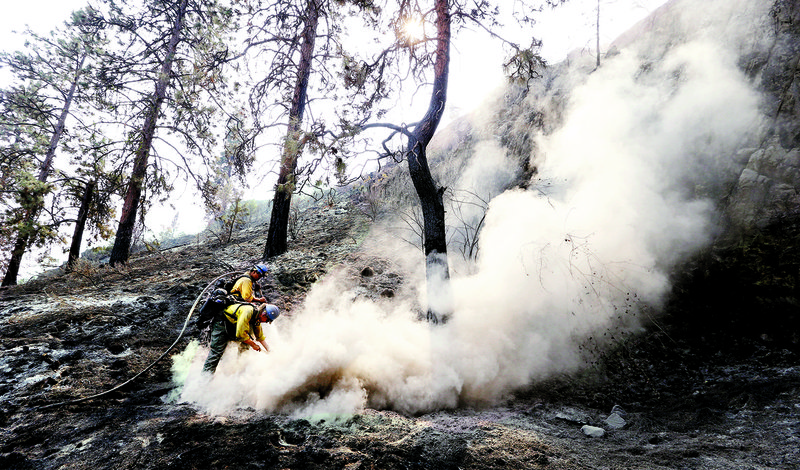Gentler winds allowed firefighters to make significant progress Sunday in battling the numerous wildfires across Washington, but heavy smoke made it difficult for those crews to receive support from the air.
As of Sunday morning, there were 16 large wildfires raging from the Blue Mountains to the North Cascades, consuming more than 980 square miles, Washington Commissioner of Public Lands Peter Goldmark said.
More than 200 homes have been destroyed, and more than 12,000 homes and thousands of other structures are still threatened, officials said.
By Sunday morning, the Okanogan County fires had burned about 374 square miles.
The complex of fires was estimated to be about 10 percent contained as of Sunday morning, fire spokesman Dan Omdal said.
Containment does not mean the fire has stopped burning. It means it has run out of fuel to burn in that area, either because it has hit a man-made fire line, an air drop of fire retardant, a road or a lake.
Some of the land within the fire lines is still burning, but other sections have burned out.
"The good news is that crews have made significant progress in improving their fire lines and the amount of containment and structure protection," Goldmark said Sunday morning. "The bad news is that the smoke is restricting visibility to a quarter of a mile this morning. There are very limited air operations possible because of that, and air operations are a vital part of a suppression strategy."
Goldmark said firefighters grappling with the Okanogan complex were trying to hold more than 1,000 miles of fire line.
"That's an enormous challenge for this team, but they seem to be getting a handle on where they need to work and where the resources need to go," he said.
The cloud of smoke was expected to lift Sunday. But as air quality improves, the fire's behavior could become more erratic and intense, fire officials said.
"It's like a flue opening in a fireplace," said Suzanne Flory, spokesman for the U.S. Forest Service and the Rocky Mountain Incident Management Team. "Smoke serves as a cap on the fire."
The good news for Sunday was that less smoke means fewer restrictions on air travel, and more fire tankers could drop water and chemical retardant, Flory said.
Air quality, which has been dangerously bad, will also improve when the smoke cloud lifts, but firefighters won't be able to take a breather. "We tell firefighters, if you see blue sky, heads up," Flory said.
Meanwhile, local officials downgraded some evacuation notices, allowing some people to return to their homes. Thousands remained under evacuation notices.
Sarah Miller, a spokesman with Okanogan County Emergency Management, said residents have been warned to stay ready to leave at any time and not to go looking at the fires.
Steve Surgeon, a mechanic and scrap-metal seller on the outskirts of Okanogan, said he was just happy to be alive.
He stayed as the fire raced over a ridge and barreled down toward his home, flames lapping just feet from his back porch.
"I'm alive," he said Sunday. "I shouldn't be, but I am -- and that's what matters."
Heaps of twisted and charred metal litter his land where the fire burned through. Surgeon estimates he lost more than $100,000 worth of property, including his shop, his motorcycle, several cars, a travel trailer and all of his tools.
"But I have my life and I have my home," he said. "Everything else can be replaced."
Officials said a new mobilization center was being formed at Fairchild Air Force Base outside Spokane to assist with the efforts in eastern Washington after President Barack Obama's declaration Friday of a federal emergency.
They said the center, managed by a 17-person hazard management team from San Diego, will be a staging area for 20 large fire engines and 10 water tankers from Utah, Nevada, Arizona and Colorado.
There were about 700 members of the Washington National Guard working alongside thousands of firefighters, an increase from last week, officials said.
An additional 200 National Guard members will be given fire training so they can provide relief in the near future for crews now in the field, said Maj. Gen. Bret Daugherty of the National Guard.
National Guard Black Hawk helicopters from Wyoming, Colorado and Minnesota were joining helicopters from Washington in the effort, officials said. More than 276,000 gallons of water had been poured on the fires from Black Hawk helicopters so far.
"These new assets will provide an incredible assist for our firefighters throughout eastern Washington," Gov. Jay Inslee said.
Information for this article was contributed by Donna Blankinship and Brian Skoloff of The Associated Press.
A Section on 08/24/2015
